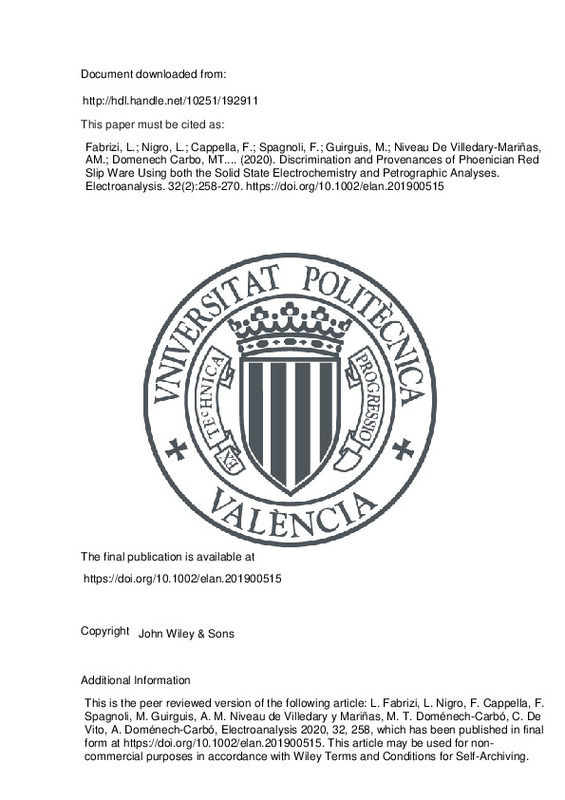Fabrizi, L.; Nigro, L.; Cappella, F.; Spagnoli, F.; Guirguis, M.; Niveau De Villedary-Mariñas, AM.; Domenech Carbo, MT.... (2020). Discrimination and Provenances of Phoenician Red Slip Ware Using both the Solid State Electrochemistry and Petrographic Analyses. Electroanalysis. 32(2):258-270. https://doi.org/10.1002/elan.201900515
Por favor, use este identificador para citar o enlazar este ítem: http://hdl.handle.net/10251/192911
|
Título:
|
Discrimination and Provenances of Phoenician Red Slip Ware Using both the Solid State Electrochemistry and Petrographic Analyses
|
|
Autor:
|
Fabrizi, Lucilla
Nigro, Lorenzo
Cappella, Federico
Spagnoli, Federica
Guirguis, Michele
Niveau de Villedary-Mariñas, Ana Maria

 Domenech Carbo, Mª Teresa
de Vito, Caterina
Doménech Carbó, Antonio
Domenech Carbo, Mª Teresa
de Vito, Caterina
Doménech Carbó, Antonio
|
|
Entidad UPV:
|
Universitat Politècnica de València. Facultad de Bellas Artes - Facultat de Belles Arts
|
|
Fecha difusión:
|
|
|
Resumen:
|
[EN] Solid state electrochemistry based on the voltammetry of immobilized microparticles (VIMP) methodology is applied to a series of 80 Phoenician Red Slip samples from the archaeological sites of Motya (Sicily, Italy), ...[+]
[EN] Solid state electrochemistry based on the voltammetry of immobilized microparticles (VIMP) methodology is applied to a series of 80 Phoenician Red Slip samples from the archaeological sites of Motya (Sicily, Italy), Mogador (Morocco), Ramat-Rahel (Israel), Sulky (Sardinia, Italy), Tas Silg (Malta), Pantelleria (Italy), and Cadiz (Spain), dated from the 8(th) to the 6(th) century BC. Upon attachment of sub-microsamples to graphite electrodes in contact with aqueous H2SO4 electrolyte, voltammetric features due to the reduction of Fe(III) minerals and the oxidation of Fe(II) ones, complemented with electrocatalytic effects on oxygen reduction and oxygen evolution reactions, provide characteristic electrochemical fingerprints for pottery samples. A consistent sample grouping discriminating between different potteries from different archaelogical sites, is obtained, all results being consistent with morphological, compositional and mineralogical data. Petrographic analysis supports the grouping, defining the manufacture and firing procedure for the different archaeological context.
[-]
|
|
Palabras clave:
|
Electrochemistry
,
Petrography
,
Ceramics
,
Phoenician
|
|
Derechos de uso:
|
Reserva de todos los derechos
|
|
Fuente:
|
Electroanalysis. (issn:
1040-0397
)
|
|
DOI:
|
10.1002/elan.201900515
|
|
Editorial:
|
John Wiley & Sons
|
|
Versión del editor:
|
https://doi.org/10.1002/elan.201900515
|
|
Código del Proyecto:
|
info:eu-repo/grantAgreement/AEI/Plan Estatal de Investigación Científica y Técnica y de Innovación 2013-2016/CTQ2017-85317-C2-1-P/ES/APLICACION DE TECNICAS AVANZADAS DE MICROSCOPIA EN EL ESTUDIO DEL PATRIMONIO CERAMICO Y VITREO/
info:eu-repo/grantAgreement/MIUR//FFABR 2017/
|
|
Descripción:
|
This is the peer reviewed version of the following article: L. Fabrizi, L. Nigro, F. Cappella, F. Spagnoli, M. Guirguis, A. M. Niveau de Villedary y Mariñas, M. T. Doménech-Carbó, C. De Vito, A. Doménech-Carbó, Electroanalysis 2020, 32, 258, which has been published in final form at https://doi.org/10.1002/elan.201900515. This article may be used for non-commercial purposes in accordance with Wiley Terms and Conditions for Self-Archiving.
|
|
Agradecimientos:
|
Project CTQ2017-85317-C2-1-P, supported with Ministerio de Economia, Industria y Competitividad (MINECO), Fondo Europeo de Desarrollo Regional (ERDF) and Agencia Estatal de Investigacion (AEI), is gratefully acknowledged. ...[+]
Project CTQ2017-85317-C2-1-P, supported with Ministerio de Economia, Industria y Competitividad (MINECO), Fondo Europeo de Desarrollo Regional (ERDF) and Agencia Estatal de Investigacion (AEI), is gratefully acknowledged. We are grateful to the Sapienza University of Rome fund for Great Excavations for supporting the project on the island of Motya which contributed to this study, as well as the Superintendency of Trapani of the Sicilian Region and G. Whitaker Foundation for providing support to the research. Financial support was provided by Sapienza University of Rome (Ateneo funding, 2016, 17, 18) and Ministero dell'Istruzione, dell'Universita e della Ricerca (funding FFABR 2017). PhD grants of the Department of Earth Sciences, Sapienza University of Rome, are gratefully acknowledged.
[-]
|
|
Tipo:
|
Artículo
|







![[Cerrado]](/themes/UPV/images/candado.png)


